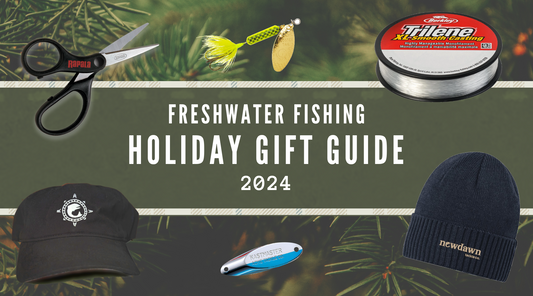
A Complete Beginner's Guide to Selecting Fishing Gear
Neil ColicchioShare
I was catching up with an old friend recently, and he asked me some questions about gear selection that really got me thinking. I started this business with the goal of making fishing accessible and easy to understand for anglers of all abilities. However, I haven't written much content for true beginners - people who've never fished or those who've never ventured out alone. While I've written guides to lure selection and tips on kayak fishing, this time, I want to focus on the basics.
Panfish are among the most prolific, hardiest, and most accessible of all freshwater fish, so most of my recommendations are aimed at getting you started with bluegills, pumpkinseeds, or other sunfish. I fish with a spinning reel, and I think that spinning reels are the most straightforward designs to use, maintain, and troubleshoot, so I'll recommend them to any beginner. I also believe that live baits are the most foolproof option to have at the end of your line, which is why I suggest starting with worms or shiners before moving on to lures. These basic tips will help you to catch fish soon and master the essentials before moving on to more challenging species.
Why Start with a Spinning Reel?
For beginners, spinning reels are the perfect choice. They're easy to use, versatile, and suitable for most lures. You can mount them on almost any rod. Just be sure to avoid rods designed for use with a baitcasting reel.
When choosing a spinning reel, look for one that operates smoothly and feels comfortable in your hand. You will generally be able to set up the reel for right-handed or left-handed operation, but be sure to check for any design limitations. For reel size, consider something in the 1000 to 2500 range for a lightweight option that's suitable for most freshwater species.
If you have multiple options for gear ratios, don't worry too much about it right now. The first number in the ratio shows how many times the spool will turn for every turn of the handle. For example, a ratio of 5:1 means the spool will turn five times for each full rotation of the handle. A higher first number means faster retrieval. You may prefer different speeds for different techniques, but it won't make much difference when fishing with worms or shiners.
The Ideal Fishing Line: 6-8 lb. Monofilament
When selecting a line for your first fishing reel, factors like weight, color, and composition are not crucial. As long as your reel can hold enough of your chosen line to reach the fish, you're good to go.
For beginners, 6 - 8 lb. monofilament is the best line option. If your reel came pre-spooled, you can almost guarantee that's what is already tied on. If not, this is a line option that is available, affordable, and durable.
At this stage in your fishing journey, the line is delicate enough for panfish and strong enough for most of the fish that you'll encounter in the same area.
Choosing the Right Rod: 2-Piece Light to Medium
If you're buying an off-the-shelf combo from your local big box store, you may not have a ton of options for rod construction, action, or power. That is completely fine. Cheap rods catch fish. I've fished combos like this in addition to yard sale and thrift store finds for most of my life. I still own a few cheap rods and reels that serve as my backups or the gear I loan to friends.
For those in search of a more premium option, I'd suggest starting with a 2-piece rod for portability. If you're not used to fitting a 6- or 7-foot rod in your vehicle, it's best not to start with a 1-piece rod. If possible, choose something light-to-medium power with a moderate-to-fast action. Don't buy a telephone pole if you're searching for panfish, and don't buy a toothpick if you're fishing around carp or pike.
The length of the rod comes down to personal preference. A rod between 6 and 7 feet is usually ideal for casting in open areas such as docks, boats, or open shorelines. If you're fishing in wooded areas or from an overgrown riverbank, a shorter rod might help you avoid getting tangled in vegetation. For fishing from a canoe or kayak, a shorter rod can also be beneficial for avoiding overhanging obstacles. Save the longer rods for surfcasting and flyfishing. You can upgrade once you master the mechanics of casting.
Selecting Terminal Tackle: The Basics
Terminal tackle is the last essential bit of kit that you'll need to hook and fight a fish. I recommend that all beginners start by fishing with live bait. Live baits appeal to the widest variety of species, drastically simplify tackle selection, and allow you to save some money for better quality rods and reels, fishing licenses, parking fees, and snacks.
There are tons of options for fishing live baits, so I'd suggest learning how to rig a bobber and how to tie a Carolina rig. Depending on which presentation you prefer, an assortment of hooks, sinkers, swivels, and, optionally, bobbers will suit you well. The same basic tackle will allow you to fish all manner of worms, small baitfish, salmon eggs, and PowerBait.
A Well-Rounded Tackle Bag
The options outlined here will work in a still pond, a moving river, or anywhere in between. If you have access to a pond, I'd suggest practicing there first. Try to fish on days when the wind is limited and find spots without boaters and swimmers around if you can. This approach will help you become familiar with the natural behaviors of the rod, line, and tackle without being affected by drifting caused by currents or wake.
Expanding Your Collection: Lures and Jigs
Once you're comfortable with the basics, you can start experimenting with different lures and jigs.
Inline spinners are a great lure that will attract almost any freshwater fish species. A gradual straight retrieve with just enough speed to cause the blade to spin will drive bass and trout wild.
Spoons are another great option that can cast far and attract all kinds of predatory fish. When retrieving the spoon, pause every so often and let it sink slightly to mimic an injured baitfish.
If you'd prefer to mimic crayfish, worms, or other non-fish prey items, you can try fishing with soft plastics. Ned rigs are a great option that you can present quickly and erratically or slowly and precisely, depending on what the fishing scenario calls for.
Experimentation and Progression
As you become more familiar with your beginner's setup, you should experiment with different line and lure weights. With practice, you'll learn how different setups affect your casting, retrieve, and overall fishing experience. Consider using thinner diameter or low-visibility lines like fluorocarbon to target finicky trout. Switch to braid if you're targeting bass in heavy cover. Try using a larger Rooster Tail to target brook trout in moving water.
Gradually building your tackle collection based on the conditions and depths where you enjoy fishing will make you a more versatile and successful angler. This approach will challenge you to be resourceful with your current gear and purposeful about what you acquire next.
Budget Considerations: Quality Matters
While it's tempting to go for the cheapest options when starting, investing in quality gear can make the experience much more enjoyable. Here is how I'd prioritize gear on a budget.:
1. Reel: Look for smooth operation and comfortable handling. A quality reel can improve casting distance and control.
2. Rod: Prioritize durability and sensitivity. A good rod will last longer and improve your overall fishing experience.
3. Line: Stick with the recommended 6-8 lb. monofilament for its balance of strength and ease of use.
Putting It All Together
To summarize, here's the recommended beginner's setup for targeting bass, trout, and panfish.:
Additional Tips for Beginners
Practice Casting: Spend time practicing your casting technique so you can get comfortable with your gear and improve your accuracy.
Learn Basic Knots: Mastering a few fishing knots will ensure your tackle and your catch are secure.
Be Patient: You will get tangled eventually. Your line will break sooner or later. There's a strong possibility you'll even hook yourself. Pay attention to what went wrong, and see if you can improve upon it with practice.
If you've ever felt nervous about purchasing fishing gear, intimidated by other people with years more fishing experience than you, or confused by the variety of products on the market, don't let that stop you from pursuing the sport. You don't need a fancy rod or reel, you really don't need expensive lures, and you surely do not need a boat. The tackle options are limitless, but with a few essential items, you can target your first fish. The most exciting part is that the first fish is a guaranteed PB (personal best) if you've never caught a fish before!
I promise I'll do more to create content for beginner and novice anglers in the future. If there's anything you can't find here on the blog, Instagram is the best place to send your questions and comments.
I'd love for you to buy some tackle from New Dawn Tackle Co. when you start fishing, but I strongly encourage you to shop within your means. I'm most interested in sharing the sport I love with other people who might enjoy it. I hope your first fishing experience leads to many more positive ones. If this post inspires you to get out there, tight lines and happy fishing!
Neil Colicchio
Owner, New Dawn Tackle Co.



